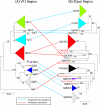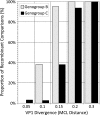The association of recombination events in the founding and emergence of subgenogroup evolutionary lineages of human enterovirus 71
- PMID: 22205739
- PMCID: PMC3302253
- DOI: 10.1128/JVI.06065-11
The association of recombination events in the founding and emergence of subgenogroup evolutionary lineages of human enterovirus 71
Abstract
Enterovirus 71 (EV71) is responsible for frequent large-scale outbreaks of hand, foot, and mouth disease worldwide and represent a major etiological agent of severe, sometimes fatal neurological disease. EV71 variants have been classified into three genogroups (GgA, GgB, and GgC), and the latter two are further subdivided into subgenogroups B1 to B5 and C1 to C5. To investigate the dual roles of recombination and evolution in the epidemiology and transmission of EV71 worldwide, we performed a large-scale genetic analysis of isolates (n = 308) collected from 19 countries worldwide over a 40-year period. A series of recombination events occurred over this period, which have been identified through incongruities in sequence grouping between the VP1 and 3Dpol regions. Eleven 3Dpol clades were identified, each specific to EV71 and associated with specific subgenogroups but interspersed phylogenetically with clades of coxsackievirus A16 and other EV species A serotypes. The likelihood of recombination increased with VP1 sequence divergence; mean half-lives for EV71 recombinant forms (RFs) of 6 and 9 years for GgB and GgC overlapped with those observed for the EV-B serotypes, echovirus 9 (E9), E30, and E11, respectively (1.3 to 9.8 years). Furthermore, within genogroups, sporadic recombination events occurred, such as the linkage of two B4 variants to RF-W instead of RF-A and of two C4 variants to RF-H. Intriguingly, recombination events occurred as a founding event of most subgenogroups immediately preceding their lineage expansion and global emergence. The possibility that recombination contributed to their subsequent spread through improved fitness requires further biological and immunological characterization.
Figures




References
-
- Andersson P, Edman K, Lindberg AM. 2002. Molecular analysis of the echovirus 18 prototype: evidence of interserotypic recombination with echovirus 9. Virus Res. 85:71–83 - PubMed
-
- Bailly JL, et al. 2009. Phylogeography of circulating populations of human echovirus 30 over 50 years: nucleotide polymorphism and signature of purifying selection in the VP1 capsid protein gene. Infect. Genet. Evol. 9:699–708 - PubMed
-
- Benschop K, et al. 2010. Comprehensive full length sequence analyses of human parechoviruses; diversity and recombination. J. Gen. Virol. 91:151–154 - PubMed
-
- Benschop KS, Williams CH, Wolthers KC, Stanway G, Simmonds P. 2008. Widespread recombination within human parechoviruses: analysis of temporal dynamics and constraints. J. Gen. Virol. 89:1030–1035 - PubMed
-
- Bible JM, Pantelidis P, Chan PKS, Tong CYW. 2007. Genetic evolution of enterovirus 71: epidemiological and pathological implications. Rev. Med. Virol. 17:371–379 - PubMed
Publication types
MeSH terms
Substances
Associated data
- Actions
- Actions
- Actions
- Actions
- Actions
- Actions
- Actions
- Actions
- Actions
- Actions
- Actions
- Actions
- Actions
- Actions
- Actions
- Actions
- Actions
- Actions
- Actions
- Actions
- Actions
- Actions
- Actions
- Actions
- Actions
- Actions
- Actions
- Actions
- Actions
- Actions
- Actions
- Actions
- Actions
- Actions
- Actions
- Actions
- Actions
- Actions
- Actions
- Actions
- Actions
- Actions
- Actions
- Actions
- Actions
- Actions
- Actions
- Actions
- Actions
- Actions
- Actions
- Actions
- Actions
- Actions
- Actions
- Actions
- Actions
- Actions
- Actions
- Actions
- Actions
- Actions
- Actions
- Actions
- Actions
- Actions
- Actions
- Actions
- Actions
- Actions
- Actions
- Actions
- Actions
- Actions
- Actions
- Actions
- Actions
- Actions
- Actions
- Actions
- Actions
- Actions
- Actions
- Actions
- Actions
- Actions
- Actions
- Actions
- Actions
- Actions
- Actions
- Actions
- Actions
- Actions
- Actions
- Actions
- Actions
- Actions
- Actions
- Actions
- Actions
- Actions
- Actions
- Actions
- Actions
- Actions
- Actions
- Actions
- Actions
- Actions
- Actions
- Actions
- Actions
- Actions
- Actions
- Actions
- Actions
- Actions
- Actions
- Actions
- Actions
- Actions
- Actions
- Actions
- Actions
- Actions
- Actions
- Actions
- Actions
- Actions
- Actions
- Actions
- Actions
- Actions
- Actions
- Actions
- Actions
- Actions
- Actions
- Actions
- Actions
- Actions
- Actions
- Actions
- Actions
- Actions
- Actions
- Actions
- Actions
- Actions
- Actions
- Actions
- Actions
- Actions
- Actions
- Actions
- Actions
- Actions
- Actions
- Actions
- Actions
- Actions
- Actions
- Actions
- Actions
- Actions
- Actions
- Actions
- Actions
- Actions
- Actions
- Actions
- Actions
- Actions
- Actions
- Actions
- Actions
- Actions
- Actions
- Actions
- Actions
- Actions
- Actions
- Actions
- Actions
- Actions
- Actions
- Actions
- Actions
- Actions
- Actions
- Actions
- Actions
- Actions
- Actions
- Actions
- Actions
- Actions
- Actions
- Actions
- Actions
- Actions
- Actions
- Actions
- Actions
- Actions
- Actions
- Actions
- Actions
- Actions
- Actions
- Actions
- Actions
- Actions
- Actions
- Actions
- Actions
- Actions
- Actions
- Actions
- Actions
- Actions
- Actions
- Actions
- Actions
- Actions
- Actions
- Actions
- Actions
- Actions
- Actions
- Actions
- Actions
- Actions
- Actions
- Actions
- Actions
- Actions
- Actions
- Actions
- Actions
- Actions
- Actions
- Actions
- Actions
- Actions
- Actions
- Actions
- Actions
- Actions
- Actions
- Actions
- Actions
- Actions
- Actions
- Actions
- Actions
- Actions
- Actions
- Actions
- Actions
- Actions
- Actions
- Actions
- Actions
- Actions
- Actions
- Actions
- Actions
- Actions
- Actions
- Actions
- Actions
- Actions
- Actions
- Actions
- Actions
- Actions
- Actions
- Actions
- Actions
- Actions
- Actions
- Actions
- Actions
- Actions
- Actions
- Actions
- Actions
- Actions
- Actions
- Actions
- Actions
- Actions
- Actions
- Actions
- Actions
- Actions
- Actions
- Actions
- Actions
- Actions
- Actions
- Actions
- Actions
- Actions
- Actions
- Actions
- Actions
- Actions
- Actions
- Actions
- Actions
- Actions
- Actions
- Actions
- Actions
- Actions
- Actions
- Actions
- Actions
- Actions
- Actions
- Actions
- Actions
- Actions
- Actions
- Actions
- Actions
- Actions
- Actions
- Actions
Grants and funding
LinkOut - more resources
Full Text Sources
Miscellaneous

